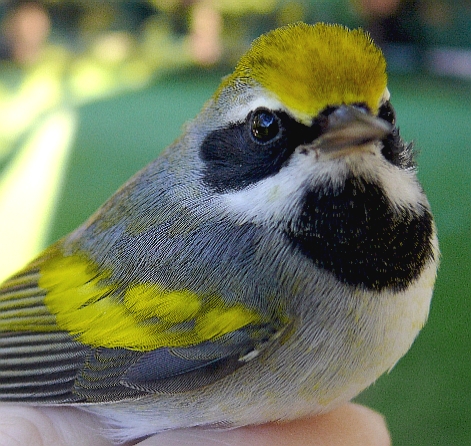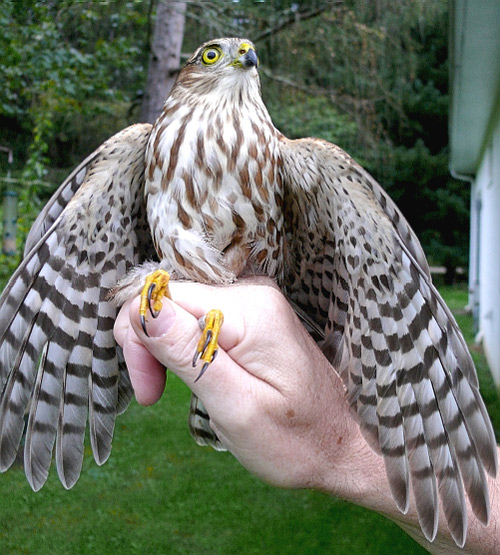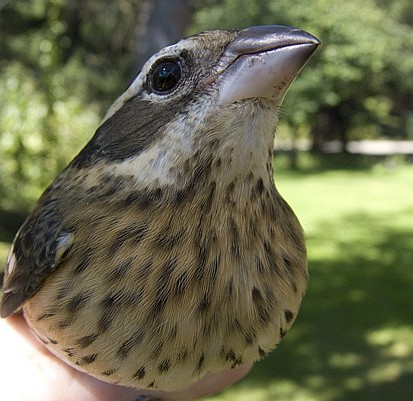September 2007

We're still trying to catch up this season with our Recent Notes and Pictorial Highlights. Accordingly, this page summarizes our results for the four full banding weeks (Tuesday-Sunday) in September. As usual, this middle portion of our fall banding season was more productive than the earlier (August) part. And, as the next installment likely will show, September banding ordinarily it is much less productive than October (or even early November), when we invariably see our highest daily fall banding totals and capture rates. So, please STAY TUNED! We hope to update through the middle of October very shortly.
The September period summarized in this update netted us 2,518 "new" birds of 83 species, plus 218 recaptures. Our most productive banding days were 9/19 (160 birds; 38 species; 53 birds/100 net-hours), 9/14 (194 birds; 31 species; 52 birds/100 net-hours). 9/18 (220 birds; 43 species; 51 birds/100 net-hours), 9/22 (225 birds; 37 species; 75 birds/100 net-hours), and 9/25 (179 birds; 34 species; 73 birds/100 net-hours). Our overall banding total for the period included 1,012 wood warblers of 28 species, four of these being among the "top ten" species banded. Total banding effort in September was 6,140 net hours, giving an overall capture rate (for "new" birds) of 42 birds/100 net-hours (about average).
The top species banded during the period were American Goldfinch (371 banded), Gray Catbird (193), Swainson's Thrush (170), Common Yellowthroat (155), Red-eyed Vireo (94), Hooded Warbler (94), American Redstart (79), Rose-breasted Grosbeak (76), Black-throated Green Warbler (64), Ruby-throated Hummingbird (61), and Black-capped Chickadee (61). Banding totals for fifteen species, e.g., Sora, Belted Kingfisher, Hairy Woodpecker and Red-breasted Nuthatch, were represented by just a single bird.
We thank Mary and Alex Shidel, Lauren Schneider, Brent Worls, Emma DeLeon, Ben Coulter, Lewis Grove, Kristin Sesser, Matt Shumar, David Liebmann, Cailin O'Connor, Bob Powell, Guy Ubaghs, and Rosemary Spreha for their help with banding this period.

Highlights from the first full banding week in September 2007 (9/4-9/9).
Daily banding totals this week ranged from 45-65 individuals of 17-26 species with 135-160 net hours of effort, giving a capture rate of 33-43 birds banded/100 net-hours.
We banded our first Cape May Warbler of the season, an adult (AHY) male, on September 5.



Just a day later, we banded a species that we haven't caught at Powdermill since 2002. This time, instead of a confusing fall warbler quiz, we've propose this confusing foot quiz.
An immature (HY) Sora, only the thirteenth in the program's 46 year history!

And, the very next day, we added a second Belted Kingfisher to our season total, this adult female, banded on September 7.

Highlights from the second full banding week in September 2007 (9/11-9/16)
The pace of the season picked up in all respects during the second full banding week of the month. Daily banding totals this week ranged from 46-194 individuals of 21-31 species with 165-375 net hours of effort, giving a capture rate of 20-62 birds banded/100 net-hours.
We banded our first Golden-winged Warbler of the season, an immature (HY) male, on 9/12.

An immature female Yellow-breasted Chat banded on 9/13 was also a first for the season.


On 9/15 we caught and banded our first Sharp-shinned Hawk, a small (<90 grams) immature (HY) male

The second full week of banding this month ended with the capture of a very late migrant adult (AHY) male Yellow Warbler. Fewer than twenty YWARs have ever been banded at Powdermill after 9/15.
Such late season birds often are ascribable to one of the northwestern, i.e., Alaskan, subspecies, such as Dendroica petechia rubiginosa. Most late YWARs we've banded have been very dull greenish HY birds.
This comparatively very bright adult male does show the characteristic dull greenish forecrown and somewhat reduced ventral streaking typical of D. p. rubiginosa.


Highlights from the third full banding week of September 2007 (9/18-9/23)
The peak numbers and diversity of September migrants usually occurs during the third week of the month, and this season was no exception. Daily banding totals this week ranged from 79-225 individuals of 29-43 species with 300-435 net hours of effort, giving a capture rate of 26-75 birds banded/100 net-hour.
On 9/19, we netted an unusual looking Rose-breasted Grosbeak (an adult female) that exhibited some intergrade characteristics with Black-headed Grosbeak (a dark buffy breast and dark crown contrasting with a coppery brown back; the heavy breast streaking is pure Rose-breasted, though).
Interestingly, in the last five years or so it has become more or less usual to capture one or more of these putative hybrid grosbeaks, suggesting the possibility that the hybrid zone and/or migratory routes of birds from the zone of intergradation may be shifting eastward.

An interesting color variant grosbeak, an adult (AHY) female Rose-breasted with salmon-pink undwerwing linings, was banded on 9/21.

Continuing with the theme of hybrids and color variants (see also the second photo highlight below for the last week in September), an adult male Blue-winged Warbler banded on 9/20 had broad yellowish white (rather than narrow white) wing bars.
This suggests genetic introgression with Golden-winged Warbler sometime within its comparatively recent family history.


Two Hooded Warbler banded on 9/20 looked very similar, yet they differed both in age and sex! (in both photos to your left, an adult female is on the left and an HY male is on the right)

There was nothing unusual about this adult male American Redstart. We just couldn't help but show off this handsome full frame photo.

Highlights from the last full banding week in September 2007 (9/25-9/30)
As expected, both numbers and diversity dropped off slightly during the last week of September (numbers, but not diversity, will pick up again strongly moving into October). Daily banding totals this week ranged from 96-179 individuals of 30-36 species with 215-40 net hours of effort, giving a capture rate of 24-73 birds banded/100 net-hour.
This was the week of our advanced bander development workshop, and the weather and the birds cooperated very well. Our thanks to workshoppers Bob Powell and Cailin O'Connor (not pictured) and the rest of the week's participants (from left to right): Bob Powell, Adrienne Leppold, Bob Mulvihill, Pam Ferkett, Molly McDermott, and Bob Leberman



Another unusual looking Rose-breasted Grosbeak was this melanistic (extra dark pigmentation in places) HY-F banded on 9/30.

We banded our first American Woodcock of the season (an HY-M) on 9/30. The photo to your left shows the detailed pattern of its inner secondaries, in particular the distinct subterminal black band that marks the bird as an immature (HY).
Woodcocks are sexed based on measurements of their wing and bill (males are considerably smaller than females). This HY male was still molting in its primary wing feathers, making accurate measurement of these impossible, but its bill (specifically, its exposed culmen) measured 65.5 millimeters (this same measurement is > or = 70 mm in females).


The next photos show the bird just released on the lawn outside the banding lab after banding. Woodcocks will "freeze" and rely on their cryptic coloration to escape detection (an effect that is greatly enhanced for color-blind predators, like most mammals, as illustrated by the right-hand B & W photo); plus, the position of their eyes far back on their head gives them an exceptionally wide field of view, making it nearly impossible for an animal to sneak up from behind or above them!


An immature (HY) Yellow-billed Cuckoo (top photo) banded on 9/27 was our third for the season; an HY-M Yellow-bellied Sapsucker banded on 9/29 (bottom photo) was our second of that species to band this fall.
The YBCU was in a more advanced stage of its first prebasic molt, having already replaced its first two primaries, corresponding primary coverts, and all its alula feathers; more than is usually seen north of its wintering grounds. Similarly, as the photo to your left shows, sapsuckers ordinarily are very slow to replace even their juvenal body plumage in the fall, accomplishing most of their 1st PB molt over the course of winter.

While fault or growth bars are more commonly indicative of HY/SY birds, adult birds can show them as well, as is the case with the Mourning Warbler pictured to your left. A fault bar is usually the result of some environmental or nutritional stress that the bird encountered while it was growing in the feathers.
Because groups of feathers on HY birds grow in all at the same time, a stress that results in a fault bar on the feathers is distributed in an even line (this can even be helpful in confirming the age of some HY birds). However, on an adult, the feathers are sequentially grown. So, the fault line on the feathers is, ever so slightly, in an uneven line. Note this in the picture below.


An immature (HY) female Hairy Woodpecker banded on 9/28 (top photo) was our first for the season, as was the adult (AHY) female Red-breasted Nuthatch banded on 9/29 (bottom photo below).
